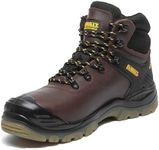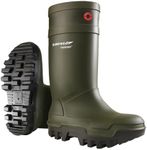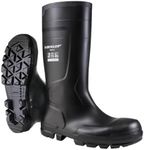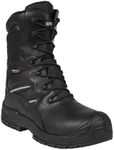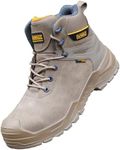Buying Guide for the Best Waterproof Work Boots
When choosing waterproof work boots, it's essential to consider the environment and conditions in which you'll be using them. The right pair of boots will not only keep your feet dry but also provide comfort, support, and protection throughout your workday. Consider the type of work you do, the surfaces you'll be walking on, and the weather conditions you typically face. This will help you determine the features that are most important for your needs.Waterproof MaterialWaterproof material is crucial for keeping your feet dry in wet conditions. This feature is important because it prevents water from seeping into the boots, which can lead to discomfort and even health issues like blisters or fungal infections. Waterproof materials can range from treated leather to synthetic fabrics with waterproof membranes. If you work in consistently wet environments, look for boots with a high-quality waterproof membrane like Gore-Tex. For occasional exposure to moisture, water-resistant treated leather might suffice.
DurabilityDurability refers to how well the boots can withstand wear and tear over time. This is important because work boots are often subjected to harsh conditions, and you want them to last as long as possible. Durable boots are typically made from high-quality materials like full-grain leather or heavy-duty synthetics. If your work involves heavy physical activity or rough terrain, prioritize boots with reinforced stitching and robust construction. For lighter tasks, a less rugged but still durable option may be appropriate.
Comfort and FitComfort and fit are essential for ensuring that you can wear your boots for extended periods without discomfort. This is important because ill-fitting boots can cause blisters, foot pain, and other issues. Comfort features to look for include cushioned insoles, padded collars, and breathable linings. When choosing the right fit, consider the shape of your foot and whether you need extra room for thick socks or orthotic inserts. Trying on boots at the end of the day when your feet are slightly swollen can help ensure a good fit.
Safety FeaturesSafety features in work boots are designed to protect your feet from potential hazards. This is important if you work in environments where there is a risk of injury from falling objects, sharp materials, or electrical hazards. Common safety features include steel or composite toe caps, slip-resistant soles, and puncture-resistant midsoles. If your job involves heavy machinery or hazardous materials, prioritize boots with comprehensive safety features. For less risky environments, basic safety features may be sufficient.
TractionTraction refers to the grip that the soles of the boots provide on various surfaces. This is important for preventing slips and falls, especially in wet or oily conditions. Boots with good traction typically have deep, multi-directional treads made from rubber or other slip-resistant materials. If you work on slippery surfaces, look for boots with specialized slip-resistant soles. For general use, a standard rubber sole with decent tread should provide adequate traction.
InsulationInsulation in work boots helps keep your feet warm in cold conditions. This is important if you work outdoors or in unheated environments during the winter months. Insulated boots are typically lined with materials like Thinsulate or wool, which trap heat and provide warmth. If you work in extremely cold conditions, opt for boots with high levels of insulation. For milder climates, a lightly insulated boot may be more comfortable and versatile.
